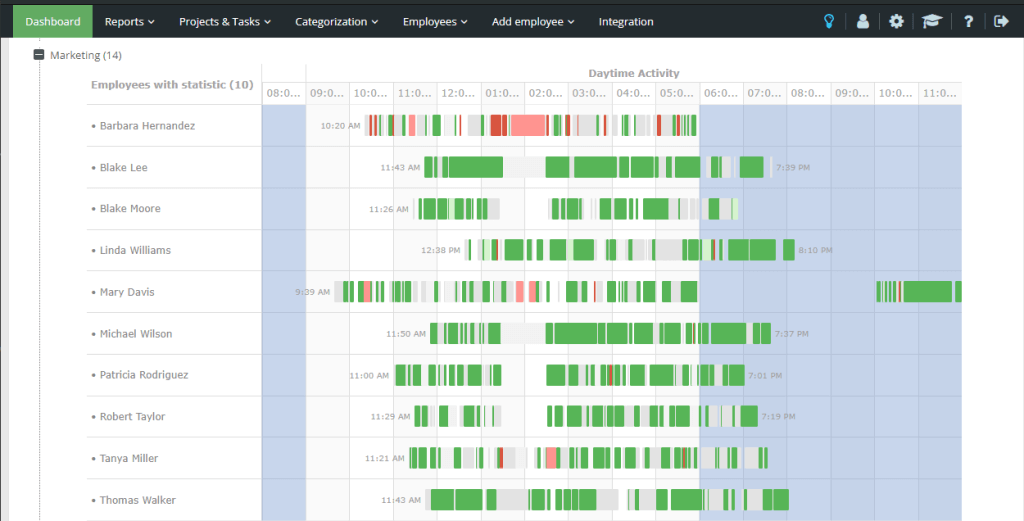HR departments face an invisible crisis. Teams appear busy and productive on the surface, but beneath that activity, burnout builds quietly until valuable employees suddenly quit. Traditional performance metrics miss the warning signs completely. When someone finally admits they're overwhelmed, it's often too late to prevent their departure. Smart HR leaders need better tools to spot trouble before it becomes a resignation letter.
Why burnout is a growing risk in remote and hybrid HR teams
Remote work eliminated many office stress indicators that HR professionals used to notice naturally. No one sees the exhausted slump at 3 PM or the frantic multitasking between video calls. Digital overload replaces water cooler conversations, and Slack fatigue becomes the new normal for many teams.
The financial impact hits hard. Burnout-related turnover costs approximately 33% of an employee's annual salary when you factor in recruitment, training, and lost productivity. For a $75,000 role, that means $25,000 in direct costs every time someone leaves because they couldn't handle the workload anymore.
Emotional disengagement often precedes actual burnout by several weeks. AI time tracking for HR reveals these patterns through changes in work behavior that traditional management approaches simply cannot detect. The data shows declining engagement before managers or teammates notice anything wrong.
What traditional time tracking misses about real employee well-being
Most time tracking systems focus on task completion and hours logged. These metrics tell you what got done but reveal nothing about the human cost of getting there. Someone might complete every assignment on time while working in a constant state of stress and fragmentation.
Legacy systems capture clock-ins, project hours, and basic productivity reports. They miss the quality of focus time, the frequency of task switching, and the subtle signs of mental fatigue that predict burnout. HR burnout prevention requires deeper insights into how people actually experience their workday.
Task completion rates can stay steady even as someone approaches their breaking point. The real indicators live in the patterns: longer time spent on routine tasks, increased reactive work, and decreased voluntary communication with teammates. Traditional tracking systems ignore these behavioral signals completely.
How AI time tracking helps HR spot early signals of disengagement
Modern AI systems analyze work patterns to identify stress indicators that human observation misses. The technology recognizes changes in behavior that typically precede voluntary resignations by 4-6 weeks. This early warning system gives HR teams time to intervene with support rather than replacement planning.
Early warning signals that AI time tracking reveals:
- Reduction in deep focus time – Less sustained concentration periods indicate mounting cognitive overload
- Increased task fragmentation – More frequent switching between activities suggests difficulty maintaining priorities
- Higher time in reactive work – Growing percentage of day spent responding to emails and unexpected requests
- Slower completion speed for recurring tasks – Familiar work taking longer often signals mental fatigue
- Missing self-initiated updates – Decreased voluntary communication with managers or teammates
These behavioral changes create a clear picture of declining engagement before performance metrics show any problems. Time tracking software for HR transforms these insights into actionable intelligence that prevents talent loss.
Real example of how AI insights helped improve retention in a 100-person team
A fast-growing SaaS company noticed their marketing team was losing experienced people every quarter. Exit interviews revealed burnout as the primary reason, but managers had no advance warning. The departing employees had maintained good performance right up until they quit.
After implementing AI time tracking, HR discovered a pattern. Three weeks before each resignation, the data showed declining deep work periods and increasing reactive task time. People were getting pulled into more meetings, handling more urgent requests, and losing time for strategic thinking.

HR analytics tools revealed that high performers were actually working differently than struggling team members, but the traditional metrics made them look identical. HR used this insight to redistribute workload and create protected focus time for the most valuable contributors. Over the next six months, voluntary turnover dropped 40% in that department.
Ethical time tracking with AI means clarity not surveillance
Implementing AI monitoring successfully requires transparency and trust-building with employees. The goal involves supporting team health, not creating anxiety about being watched. Ethical deployment focuses on aggregate patterns and team trends rather than individual performance policing.
Principles for ethical AI time tracking implementation:
- No screen recordings or keyboard logs – Track activity patterns without capturing private content
- Focus on trends, not individuals – Use data to understand team dynamics rather than evaluate specific people
- Transparency with teams – Share insights openly and explain how the data helps everyone
- Opt-in check-ins based on data – Use patterns to offer support rather than demand explanations
- Insights used for support, not discipline – Apply findings to improve working conditions and reduce stress
This approach builds trust while providing the insights HR needs to reduce employee turnover with AI. Teams appreciate understanding their own work patterns when the information helps them rather than judges them.
How to start using AI time tracking in your HR strategy
Begin with a pilot program involving one team that's open to trying new approaches. Install the tracking software and observe patterns for 2-3 weeks before drawing any conclusions. Look for the behavioral indicators that predict disengagement rather than trying to optimize pure productivity metrics.
Test the insights by having informal conversations with team members about workload and stress levels. Compare what people tell you with what the data reveals. AI workplace insights become valuable when they help you ask better questions and offer more targeted support.
Use the information in team retrospectives and one-on-one meetings. Share aggregated findings about work patterns and ask for input on improving processes. The technology works best when it starts conversations rather than replacing them. Integration with existing HR systems is typically straightforward and non-invasive.
Ready to see what early burnout signals look like in your team? Register for a free dashboard trial and view your team's real work patterns without any commitment.

